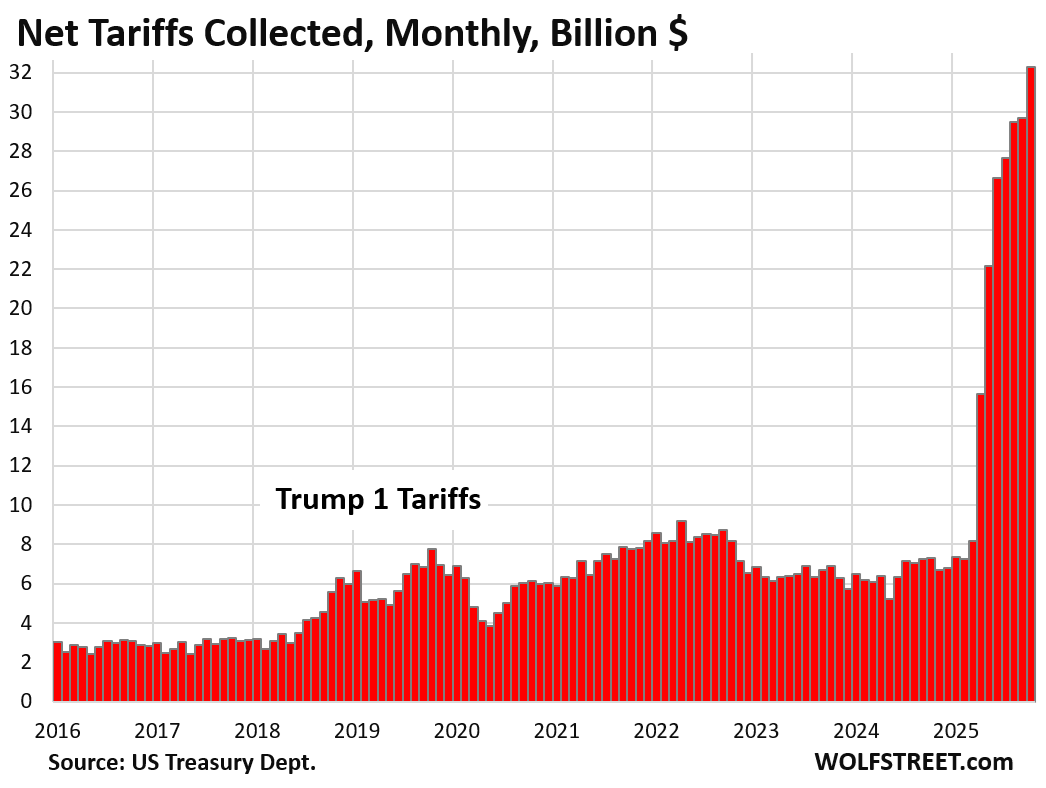The Supreme Court could strike down a portion of the tariffs, but the Administration sees similar tariffs under different Acts. “You should assume they’re here to stay”: Bessent.
By Wolf Richter for WOLF STREET.
The net amount in tariffs, after refunds, that the federal government collected jumped to a record $32 billion in October.
Since the tariff cash began flowing into the Treasury General Account (the government’s checking account) in April, the government has collected $184 billion in tariffs in ever larger monthly increments.

Compared to corporate income taxes. If collections from tariffs run at the October pace for a full fiscal year, they would generate $384 billion in receipts. It’s not nothing: Corporate income tax receipts received by the Treasury during the Fiscal Year through September amounted to $452 billion, or $37.7 billion per month on average.
The rate of tariffs in October was just 15% less than average corporate income tax receipts, representing a meaningful reduction of the terrible fiscal deficit of what it would be without the tariffs.
Methodology: The tariff data is from the Monthly Treasury Statement (MTS), except for October, which is from the Daily Treasury Statement (DTS) for October 31, released today. The DTS lists “customs duties” and “certain excise taxes” combined as one line item. The MTS – the October edition will be released later in November – separates “customs duties” from “excise taxes.” The difference between the DTS figure and the MTS figure reflects the excise taxes and has averaged $1.7 billion a month for the past 12 months and $1.9 billion for the past three months. So the October figure here is the DTS amount of $34.2 billion minus $1.9 billion in estimated excise taxes.
If the Supreme Court rules against the Trump administration, the tariffs that would be invalidated are only the “reciprocal” tariffs that were imposed by executive orders under the 1977 International Emergency Economic Powers Act (IEEPA), citing as trigger the huge trade deficits as an “unusual and extraordinary threat to the national security and economy of the United States.”
All other tariffs imposed by Trump’s executive orders under different Acts would remain valid, such as those imposed under the Trade Expansion Act of 1962, Section 232 to protect strategic sectors including motor vehicles, semiconductors, pharmaceuticals, robotics, aircraft, and copper; and under Section 301 involving unfair trade practices investigations.
Bessent pointed out in an interview, if the tariffs imposed under IEEPA are struck down, the Administration will be ready to impose similar tariffs under different Acts, for example under Section 338 of the Tariff Act of 1930, which allows the imposition of tariffs up to 50% on countries that discriminate against US commerce; or Section 122 of the Trade Act of 1974, which allows broad 15% tariffs for 150 days to calm trade imbalances.
“You should assume that they’re here to stay,” Bessent said.
So whatever the Supreme Court ruling will be, the 2025 vintage tariffs won’t go away, though they may be somewhat smaller and a little different than what they’re now. All of this uncertainty obviously contributes to the tariff chaos that has been going on for 10 months.
In case you missed it:
Enjoy reading WOLF STREET and want to support it? You can donate. I appreciate it immensely. Click on the mug to find out how:
![]()


“$452 million” perhaps should be “$452 billion”
I was just dreaming of the good old times when $452 million was still worth something 🤣
Thanks.
It’s quite jaw dropping that we’re within striking distance of collecting as much tariff revenue as we do corporate tax revenue. I’m of the opinion that the later is the problem, since it only represents about 11% of all federal government revenue.
Seems like that monthly tariff revenue would fund a year of the Obamacare expansion and open up the government.